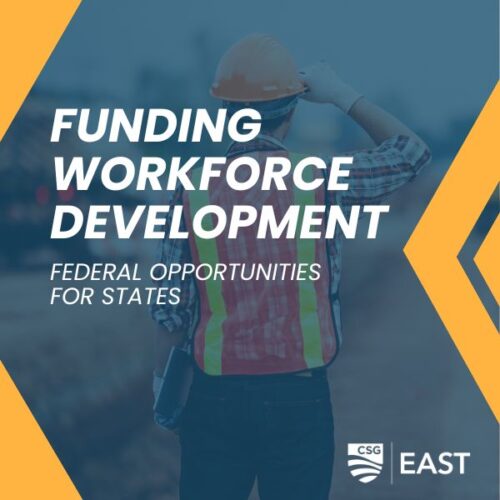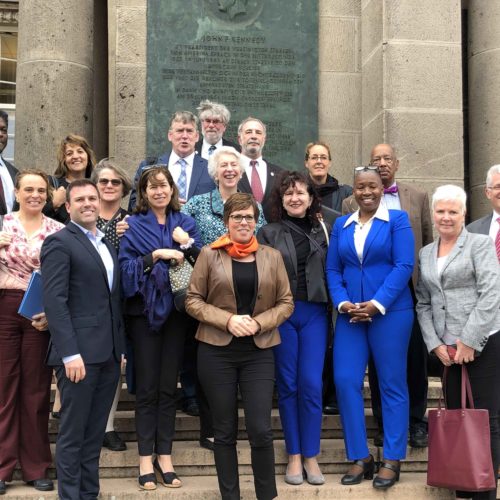Untapped talent: Creating economic opportunity for refugee and immigrant professionals
This article appears in the 2021-22 edition of Perspectives.

Credit: Adobe Stock
In the early stages of the COVID-19 pandemic, as states raced to expand health care capacity, New Jersey Governor Phil Murphy signed an executive order that created a long-awaited opportunity for foreign-born health care professionals.
The order authorized New Jersey’s Division of Consumer Affairs to grant temporary licenses to doctors licensed in foreign countries. It was a major breakthrough for advocates who have long pointed to immigrant and refugee professionals, especially those working in health care, as some of the nation’s most underutilized workers. Granting temporary exceptions to strict testing and licensure requirements would, they argued, finally allow for a sorely needed influx of high-skill, ready-to-work physicians, nurses, and specialists.
In New Jersey, their predictions came true. Shortly after the ink dried on Executive Order 112, more than 1,100 foreign-born health care professionals applied, making New Jersey’s effort one of the most successful in the nation in terms of applications received.
Now, these workers and their advocates are pushing for more permanent solutions to long-standing licensing hurdles and other barriers to entry. These outdated statutes, they argue, have driven a wedge between employers and the thousands of foreign-born workers seeking to apply their skills and fill critical work force shortages.
The issue — currently the subject of several state task forces and working groups — was explored in depth during the CSG East virtual Annual Meeting last August.
Work force shortages and the new Americans ready to fill them
In its report on “brain waste,” the Migration Policy Institute, a nonprofit, estimates that there are nearly 2 million immigrants and refugees with degrees that are unutilized or underutilized.
In health care, the report showed roughly 263,000 immigrants, refugees, asylees, and temporary residents who are authorized to work and have at least an undergraduate degree in the health care field but are currently unemployed or are employed in a job that requires no more than a high school diploma.
That’s important, advocates say, because the need for these workers is growing more urgent over time. According to data published by the Association of American Medical Colleges in June, the United States will face a shortage of up to 124,000 physicians by 2034.
During the CSG East panel, Lubab Al-Quraishi, a pathologist who fled Iraq in 2014, discussed the hurdles that prevented her from finding suitable employment in New Jersey.
“I was full of hope that I would continue [working in health care], because I have experience, training, and education,” said Al-Quraishi. “But, unfortunately, there were a lot of barriers, including financial barriers.”
Al-Quraishi, who worked for over 10 years as a pathologist and physician in Baghdad, told WNYC in an interview earlier this year that she received a temporary license in New Jersey and, although she couldn’t get a paying job, she used the license to volunteer in nursing homes, administering COVID-19 tests to residents.
As the temporary licenses granted under New Jersey’s executive order expired, however, Al-Quraishi lost her ability to work as a physician. In the interim, she says, she found a job as a pathologist’s assistant, and is currently saving money to be able to afford New Jersey’s licensing exam.
“I can’t help feeling that it shouldn’t be this hard at a time when experts often sound the alert about the shortage of physicians in the U.S.,” Al-Quraishi wrote in an opinion piece published online in April.
She added that the issue goes far beyond undervaluing health care workers. “I have lost count of the foreign-trained engineers I have met working in Walmart or foreign-trained chemists driving taxis. A friend of mine is a brilliant math teacher from Turkey. But in the U.S., which has a shortage of math teachers, she isn’t able to serve her community with her teaching skills,” she wrote.
Slow progress toward a solution
Targeted barrier-reduction studies are underway in Georgia, Maine, Maryland, Vermont, Virginia, Washington, and several other states, according to Mike Zimmer, senior policy consultant for World Education Services, a nonprofit.
“Licensing laws and requirements are often cited as a barrier to entry to a whole host of populations,” he said. “This has been exacerbated by the growth of licensing. In the ’50s, only 5 percent of the U.S. work force was required to be licensed to perform their duties.
Currently, it is estimated that number has hit over 30 percent.”
And, while licensing requirements are chiefly intended to protect public health, in the past, they have been used to discriminate against people of color.
Zimmer cited a 1994 article from the San Diego Law Review that found that, historically, white interest groups used occupational licensing laws to stifle Black economic progress.
“While generally not Jim Crow laws per se, the laws were used both in the South and the North to prevent blacks from competing with established white skilled workers,” the article found.
The statutes and the requirements that have evolved from them have created three top barriers that persist today, according to Zimmer: lack of U.S. work experience, nonrecognition of international work experience, and nonrecognition of foreign credentials.
While legislative solutions are slowly being tested around the country, many organizations are stepping up to offer immediate help to job seekers and state leaders alike.
World Education Services and New American Economy, an advocacy organization, have teamed up to run an Office of New Americans, which provides state policy leaders an opportunity to share best practices to help immigrants fully integrate into their new communities. Maryland, Massachusetts, New Jersey, and New York are all members.
Advocacy organizations have also popped up in various states and cities to help immigrants and English learners adapt to their new communities through academic coaching and career counseling. The Washington Academy for International Medical Graduates, for example, provides these services as well as opportunities for clinical experience — a key step in meeting license requirements.
Maine as a national leader
As state leaders look to the future, Maine is emerging as a national leader in integrating immigrant families and workers. An influx of refugees from Somalia and some Central African countries has changed the landscape quickly in towns like Lewiston, which has suffered from population loss in the wake of deindustrialization.
State Representative Kristen Cloutier, whose district includes Lewiston, highlighted Maine’s revolving loan program to enable credentialing and skills recognition for foreign-born workers, established last year, and LD 149, legislation she sponsored to facilitate licensure for credentialed individuals from other jurisdictions.
“Because we have so many barriers in place, these individuals are forced to work in minimum-wage jobs and positions they aren’t excited about,” she explained. “That leads to depression, exhaustion, and an inability to get out of that cycle. The longer folks are kept in these lower-level positions, the worse it is for them and our economies, our states, and the country.”
LD 149, panelists at the CSG East conference noted, fulfills several key recommendations found in a report prepared for a joint state legislative committee. The report identifies barriers and recommends strategies for foreign-credentialed individuals to become part of Maine’s skilled work force.
“[These] are the kinds of skilled employees that Maine employers are really scrambling to recruit right now,” said Cloutier. “It’s highlighted in the governor’s 10-year economic strategy, and I just think that — considering Maine’s skilled labor shortage — supporting good employees is really a top priority.”




